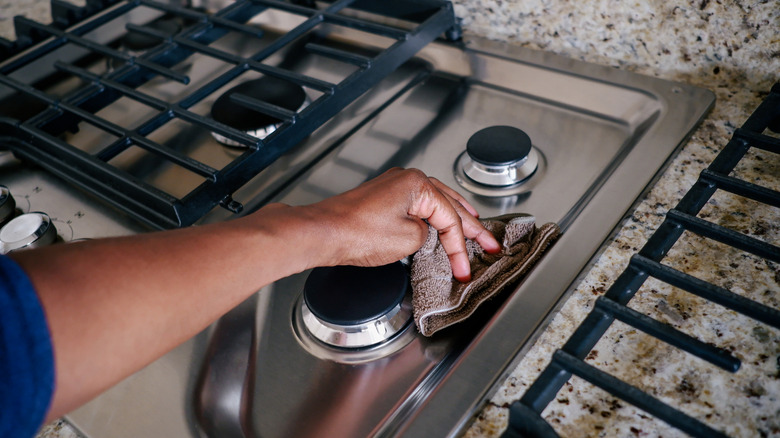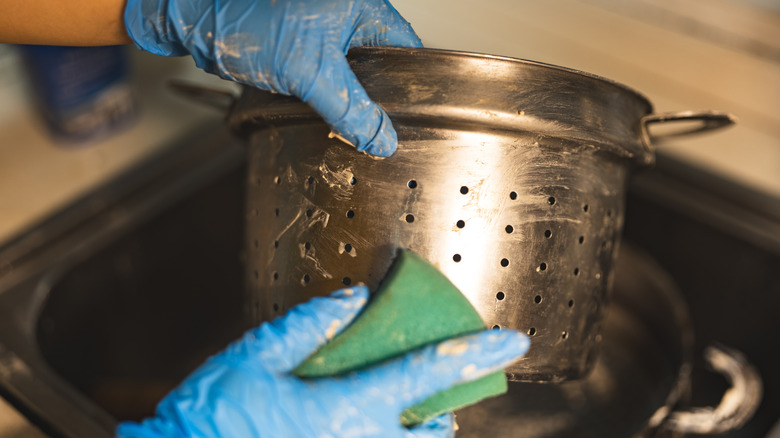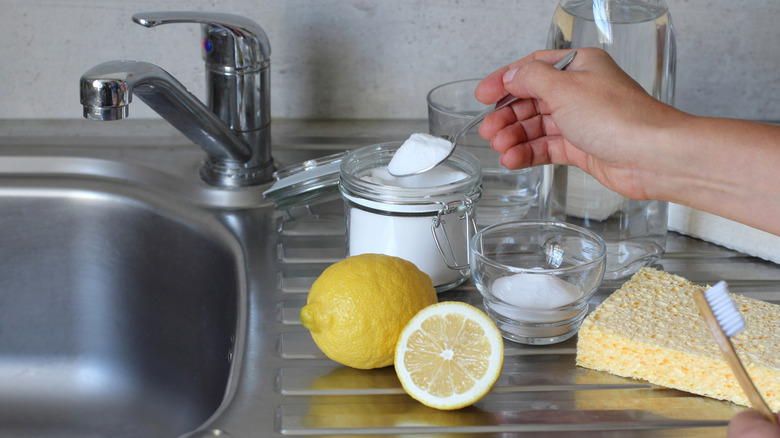Whatever You Do, Don't Clean Stainless Steel Appliances With This Kind Of Material
Cooking gets messy sometimes, and that's an unavoidable fact of life. That means cleaning your kitchen and cooking utensils is an unfortunate part of life, too. Many state-of-the-art kitchens feature stainless steel surfaces and appliances that quickly become riddled with spatters, spills, and smears. When these messes harden up, they can be difficult to remove without some serious scrubbing. But wait before you pick up that scouring pad! If you use abrasive material on them, there's a chance your stainless steel appliances will never sparkle again.
Always avoid coarse surfaces and rough scrubbing textures when cleaning stainless steel. While the metal may feel sturdy, you're likely to leave tiny scratches that will show stains, be more likely to rust, and will take away from a clean appearance. Instead, there are other ways to make stainless steel shine like new again without reaching for that steel wool. First, you need to understand exactly why a rough scrubber is your steel stove's worst enemy.
Why strong stainless steel should be treated gently
Stainless steel is one of the more resilient cooking materials on the market, but that doesn't mean it's invincible. Every cooking pot, stovetop, kettle, and utensil that uses stainless steel has a thin layer of chromium oxide meant to safeguard the metal over time. Unfortunately, that surface shows even delicate fingerprints unless you clean it well. That's where you need to start being careful. Even hard brushes can make scratches in this protective surface, which can mean long-term damage that only shows up months or years later. Thus, scouring pads, steel wool, and metal scrapers are a no-go with stainless steel.
While this may seem somewhat straightforward, you'd be surprised to learn that some unexpected cleaning products can still cause damage. Melamine sponges, such as a Mr. Eraser, are meant to remove layers of dirt and grime, but they do the same to layers of chromium. The Pink Stuff is also a no-go, as the quartz grit in it can wear down the chromium layer just as much as brushes and scouring sponges, leaving the metal dull and lacking shine. These poor maintenance choices may exacerbate food sticking, leading to increased difficulty in cleaning later. So whether you have a very useful stainless steel prep table or just a stainless steel colander, you need to be aware of what products you are using on it.
How to clean your stainless steel without causing damage
Because this is such a common issue, there are several products on the market to help you specifically clean stainless steel. Look for a neutral, low-chloride detergent, then use only a soft, clean cloth or microfiber wipe to take off marks and spilled food. Avoid abrasive cleaners that contain chlorine as a major ingredient. Follow the grain of the steel, which should be visible at a glance, for the best possible results. Brands such as Bar Keepers Friend and Sprayaway make products for these exact needs.
There are numerous ways to get your stainless steel clean without using commercial products, too. You can reach for olive oil when cleaning your pots and pans, or various other parts of your kitchen. Salt with lemon can act as a very mild abrasive without leaving scratch marks on stainless steel, as long as you are gentle with your technique. The acid in the lemon cuts through grease and stuck-on food, letting it take the place of store-bought cleaners. Consider soaking cloudy stainless steel cookware in diluted white vinegar and using it to polish the surface with a soft cloth. Of course, the best way to keep your stainless steel sparkling is to clean it immediately if you spot food or a smear on it, so it doesn't have a chance to do damage in the first place.


